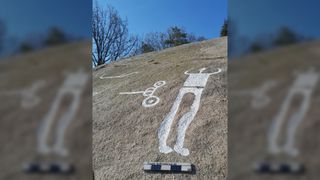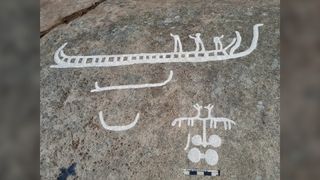2,700-year-old petroglyphs depicting people, ships and animals discovered in Sweden
About 40 ancient rock carvings have been found on a former rocky island in Sweden.

On a steep rock face in western Sweden, researchers uncovered a fascinating find: around 40 petroglyphs — depicting ships, people and animal figures — dating back around 2,700 years.
The petroglyphs were carved on a granite rock face that was once part of an island, meaning people would have had to make the carvings while standing on a boat, or from a platform constructed on ice, said Martin Östholm, a project manager with the Foundation for Documentation of Bohuslän's Rock Carvings who is one of the archaeologists who discovered the petroglyphs, told Live Science.

Bohuslän is already known for its rock carvings, including Bronze Age art made at Tanum, a United Nations Educational, Scientific and Cultural Organization (UNESCO) site. The team was looking for new petroglyphs in the area when they came across the moss-covered rock face. They noticed some lines on it that appeared to be human made, so they removed the moss, revealing the petroglyphs underneath. The rock face is too steep to stand on, Östholm said, so the team had to stand on a platform to do their archaeological work.
Related: Ancient Assyrian rock carvings in Iraq show procession of gods riding mythical animals

The petroglyphs include depictions of ships, people and animal figures, including four-legged creatures that may be horses. The biggest one shows a ship that is 13 feet (4 meters) long, Östholm said, noting that many of the petroglyphs are between about 12 and 16 inches (30 to 40 centimeters) in length.
People would have smacked hard stones against the granite rock face to create the petroglyphs, Östholm said. This action exposed a white layer underneath, making the petroglyphs highly visible, even from the mainland or passing ships. It's not certain why people created the carvings, he said, but they may have served to mark ownership.


The meanings of the carvings are also unclear, but an expert who was not involved in the discovery shared a few ideas.
Sign up for the Live Science daily newsletter now
Get the world’s most fascinating discoveries delivered straight to your inbox.
If the petroglyphs were made within a relatively short period of time, they may tell a story, said James Dodd, a researcher at Aarhus University in Denmark and the Tanums Hällristningsmuseum's Rock Art Research Centre Underslös in Sweden. Some of the motifs — including chariots, carts and animal figures — were depicted multiple times, he noted.
"On the basis of the repetition of the motifs, it is possible that this collection of figures forms a narrative," Dodd told Live Science in an email. Studies of other petroglyphs in the region have suggested that, in some cases, they may have been used in this way, but the exact meaning in this case is uncertain, he added.
The petroglyphs were discovered in early May, and research is ongoing, Östholm said.

Owen Jarus is a regular contributor to Live Science who writes about archaeology and humans' past. He has also written for The Independent (UK), The Canadian Press (CP) and The Associated Press (AP), among others. Owen has a bachelor of arts degree from the University of Toronto and a journalism degree from Ryerson University.
-
Florida Man I would expect images that old to be far less crisp and precise based on what I have seen in the American West. How was the date established and why are there no pictures showing the "moss" that was mentioned?Reply -
AncientOnes Agreed, I would expect more weathering and discoloration as well as lichen growth. However, if genuine, then I think the horses with humps might be depicting camels. Maybe someone made a long trip down the Volga before the Vikings?Reply -
OggdaBear I think I'd need more information, this seems too much like a hoax. White paint, that bright and crisp?Reply -
Bonzadog Reply
If one reads that article it said that the moss was removed. I wonder if they also toughed up the carvings - if genuine.Florida Man said:I would expect images that old to be far less crisp and precise based on what I have seen in the American West. How was the date established and why are there no pictures showing the "moss" that was mentioned? -
lepo Reply
The article mentions the moss was removed. Also a practice in Scandinavia is to paint petroglyphs in an effort to ease their visibility. Not defending the practice, just mentioning facts.Florida Man said:I would expect images that old to be far less crisp and precise based on what I have seen in the American West. How was the date established and why are there no pictures showing the "moss" that was mentioned? -
lepo Reply
A practice in Scandinavia is to paint petroglyphs in an effort to ease their visibility. Not defending the practice, just mentioning facts.OggdaBear said:I think I'd need more information, this seems too much like a hoax. White paint, that bright and crisp? -
lepo Reply
The article mentions the moss was removed. Also a practice in Scandinavia is to paint petroglyphs in an effort to ease their visibility. Not defending the practice, just mentioning facts. They're very neat there with their rock art.AncientOnes said:Agreed, I would expect more weathering and discoloration as well as lichen growth. However, if genuine, then I think the horses with humps might be depicting camels. Maybe someone made a long trip down the Volga before the Vikings?
As for the "camels", what you see are horse rider on their horse. The animals depicted look exactly like the horse linked to the chariots. -
lepo Reply
Relative datation can be obtained approximately among other things by what you can identify or recognized depicted by rock art, here for example horse riders and chariots.Florida Man said:I would expect images that old to be far less crisp and precise based on what I have seen in the American West. How was the date established and why are there no pictures showing the "moss" that was mentioned?